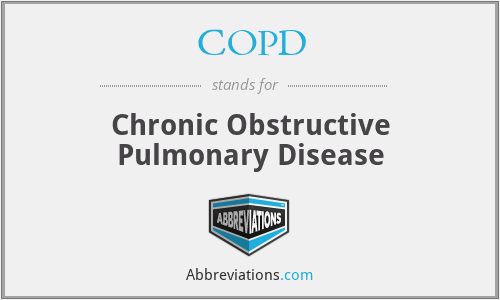What does COPD mean in Hospitals?
This page is about the meanings of the acronym/abbreviation/shorthand COPD in the Medical field in general and in the Hospitals terminology in particular.
Submitted by paul8539 on September 29, 2007
Translation
Find a translation for Chronic Obstructive Pulmonary Disease in other languages:
Select another language:
- - Select -
- 简体中文 (Chinese - Simplified)
- 繁體中文 (Chinese - Traditional)
- Español (Spanish)
- Esperanto (Esperanto)
- 日本語 (Japanese)
- Português (Portuguese)
- Deutsch (German)
- العربية (Arabic)
- Français (French)
- Русский (Russian)
- ಕನ್ನಡ (Kannada)
- 한국어 (Korean)
- עברית (Hebrew)
- Gaeilge (Irish)
- Українська (Ukrainian)
- اردو (Urdu)
- Magyar (Hungarian)
- मानक हिन्दी (Hindi)
- Indonesia (Indonesian)
- Italiano (Italian)
- தமிழ் (Tamil)
- Türkçe (Turkish)
- తెలుగు (Telugu)
- ภาษาไทย (Thai)
- Tiếng Việt (Vietnamese)
- Čeština (Czech)
- Polski (Polish)
- Bahasa Indonesia (Indonesian)
- Românește (Romanian)
- Nederlands (Dutch)
- Ελληνικά (Greek)
- Latinum (Latin)
- Svenska (Swedish)
- Dansk (Danish)
- Suomi (Finnish)
- فارسی (Persian)
- ייִדיש (Yiddish)
- հայերեն (Armenian)
- Norsk (Norwegian)
- English (English)
Definition
What does COPD mean?
- copd
- Chronic obstructive pulmonary disease (COPD) is a type of progressive lung disease characterized by long-term respiratory symptoms and airflow limitation. The main symptoms include shortness of breath and a cough, which may or may not produce mucus. COPD progressively worsens, with everyday activities such as walking or dressing becoming difficult. While COPD is incurable, it is preventable and treatable. The two most common conditions of COPD are emphysema and chronic bronchitis and they have been the two classic COPD phenotypes. Emphysema is defined as enlarged airspaces (alveoli) whose walls have broken down resulting in permanent damage to the lung tissue. Chronic bronchitis is defined as a productive cough that is present for at least three months each year for two years. Both of these conditions can exist without airflow limitation when they are not classed as COPD. Emphysema is just one of the structural abnormalities that can limit airflow and can exist without airflow limitation in a significant number of people. Chronic bronchitis does not always result in airflow limitation but in young adults who smoke the risk of developing COPD is high. Many definitions of COPD in the past included emphysema and chronic bronchitis, but these have never been included in GOLD report definitions. Emphysema and chronic bronchitis remain the predominant phenotypes of COPD but there is often overlap between them and a number of other phenotypes have also been described.The most common cause of COPD is tobacco smoking. Other risk factors include indoor and outdoor air pollution including dust, exposure to occupational irritants such as dust from grains, cadmium dust or fumes, and genetics, such as alpha-1 antitrypsin deficiency. In developing countries, common sources of indoor air pollution are the use of coal and biomass such as wood and dry dung as fuel for cooking and heating. Most people living in European cities are exposed to damaging levels of air pollution. The diagnosis is based on poor airflow as measured by spirometry.Most cases of COPD can be prevented by reducing exposure to risk factors such as smoking and indoor and outdoor pollutants. While treatment can slow worsening, there is no conclusive evidence that any medications can change the long-term decline in lung function. COPD treatments include smoking cessation, vaccinations, pulmonary rehabilitation, inhaled bronchodilators and corticosteroids. Some people may benefit from long-term oxygen therapy, lung volume reduction and lung transplantation. In those who have periods of acute worsening, increased use of medications, antibiotics, corticosteroids and hospitalization may be needed.As of 2015, COPD affected about 174.5 million people (2.4% of the global population). It typically occurs in males and females over the age of 35–40. In 2019 it caused 3.2 million deaths, 80% occurring in lower and middle income countries, up from 2.4 million deaths in 1990. The number of deaths is projected to increase further because of continued exposure to risk factors and an aging population. In the United States in 2010 the economic cost was put at US$32.1 billion and projected to rise to US$49 billion in 2020. In the United Kingdom this cost is estimated at £3.8 billion annually.
Popularity rank by frequency of use
How popular is COPD among other acronyms?
COPD#1#2725#31140
Embed
Citation
Use the citation below to add this abbreviation to your bibliography:
Style:MLAChicagoAPA
"COPD." Abbreviations.com. STANDS4 LLC, 2024. Web. 19 Apr. 2024. <https://www.abbreviations.com/term/138476>.



Discuss this COPD abbreviation with the community:
Report Comment
We're doing our best to make sure our content is useful, accurate and safe.
If by any chance you spot an inappropriate comment while navigating through our website please use this form to let us know, and we'll take care of it shortly.
Attachment
You need to be logged in to favorite.
Log In